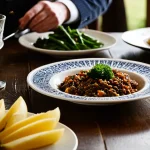Essential Ingredients and Tools for Beef Wellington
Selecting the best cut for beef Wellington is crucial; beef tenderloin is the top choice due to its tenderness and uniform shape, which cooks evenly. When making beef Wellington from scratch, the quality of ingredients directly impacts the final dish’s success. Fresh beef tenderloin ensures a juicy center, while fresh mushrooms lend depth to the duxelles.
Key beef Wellington ingredients include:
Also read : How Does British Cuisine Evolve with Global Influences?
- Beef tenderloin
- Duxelles: a finely chopped mushroom mixture
- Homemade puff pastry for wrapping
Using homemade puff pastry over store-bought elevates the texture and flavor. Precise kitchen equipment also facilitates the process. Essential tools encompass a sharp chef’s knife for clean cuts of beef and mushrooms, a food processor for finely chopping duxelles (if preferred), a rolling pin for pastry, and an oven thermometer to ensure accurate baking temperature.
Choosing quality components, such as fresh herbs and properly seasoned mushrooms, enriches the flavor profile. Prioritize fresh, firm mushrooms with low moisture to prevent soggy pastry later on. Trustworthy ingredients combine with the right tools to streamline beef Wellington ingredients handling and perfect the final creation.
In the same genre : How Can British Cuisine Inspire Your Next Dinner Party?
Preparing Homemade Puff Pastry
Creating homemade puff pastry is an essential step in making beef Wellington from scratch that elevates the dish’s texture and flavor beyond commercial versions. Puff pastry involves layering dough with butter, then folding and rolling it multiple times to create delicate, flaky layers.
Start by combining flour, salt, water, and cold butter to form the dough base. The key to flawless puff pastry is keeping all ingredients cold to prevent butter from melting prematurely. Once the initial dough is prepared, roll it into a rectangle, then fold it into thirds like a letter. Repeat this rolling and folding process at least four to six times, chilling the dough between each turn. This process is called lamination and is crucial for puff pastry’s characteristic rise and flakiness.
When working with beef Wellington pastry, resting the dough in the refrigerator between folds and before rolling reduces elasticity, preventing shrinkage during baking. Rolling the pastry evenly to an ideal thickness—usually around 3mm—is important for achieving a crisp, golden crust.
For storage, wrap the pastry tightly in plastic and refrigerate for up to two days or freeze for longer periods. Bringing frozen pastry back to fridge temperature before use helps maintain its layers. Mastering homemade puff pastry not only enhances beef Wellington pastry but also adds versatility to your culinary repertoire.
Seasoning and Searing the Beef
Proper seasoning beef Wellington is fundamental to enhance the natural flavor of the beef tenderloin and build depth in the finished dish. Start by patting the beef dry to ensure a good sear, then generously season all sides with salt and freshly ground black pepper. These basic seasonings help form a flavorful crust without overpowering the meat’s delicate taste.
When searing beef, use a heavy skillet—preferably cast iron—and heat it until very hot. Add a little oil with a high smoke point and swiftly sear the tenderloin on all sides. This process locks in juices and creates a rich, caramelized crust crucial for flavor development and texture contrast in making beef Wellington from scratch.
After searing, it’s vital to allow the beef to cool completely before proceeding. Cooling prevents premature melting of the butter in the puff pastry during assembly and avoids sogginess. Overheating can cause the pastry to become tough or unevenly cooked. Cooling also stabilizes the beef’s internal temperature, which contributes to accurately achieving the desired doneness during later baking.
In summary, seasoning beef Wellington with the right salt and pepper balance, followed by a thorough sear and complete cooling, forms the cornerstone of successful beef preparation techniques. This sequence ensures the meat remains juicy and flavorful beneath the crisp pastry shell.







